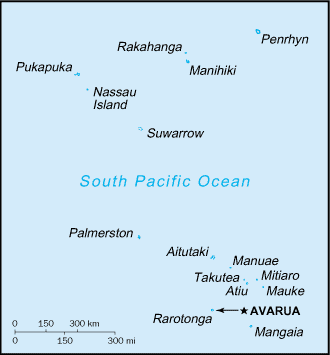|
Cook Islands
|

|
Capital: Avarua
Population: 17,548
Brief History of Cook Islands:
The first inhabitants of the Cook Islands were Polynesians who migrated there from the nearby island of Tahiti. The first Europeans to visit the Islands were the Spanish in the 16th Century. The islands were first called San Bernardo, which means Saint Bernard, and then later Gente Hermosa, which means Beautiful People.
In the late 1700s British captain James Cook arrived. He didn't name the islands either as he called them the Hervey Islands. It wasn't until later that the islands were named the Cook Islands in honor of Captain Cook.
The islands became a British protectorate in 1888, but were soon given to New Zealand to govern. Today, the Cook Islands are mostly independent while New Zealand oversees the country?s defense.
The Geography of Cook Islands
Total Size: 240 square km
Size Comparison: 1.3 times the size of Washington, DC
Geographical Coordinates: 21 14 S, 159 46 W
World Region or Continent: Oceania
General Terrain: low coral atolls in north; volcanic, hilly islands in south
Geographical Low Point: Pacific Ocean 0 m
Geographical High Point: Te Manga 652 m
Climate: tropical; moderated by trade winds
Major cities:
The People of Cook Islands
Type of Government: self-governing parliamentary democracy
Languages Spoken: English (official), Maori
Independence: none (became self-governing in free association with New Zealand on 4 August 1965 and has the right at any time to move to full independence by unilateral action)
National Holiday: Constitution Day, first Monday in August (1965)
Nationality: Cook Islander(s)
Religions: Cook Islands Christian Church 55.9%, Roman Catholic 16.8%, Seventh-Day Adventists 7.9%, Church of Latter Day Saints 3.8%, other Protestant 5.8%, other 4.2%, unspecified 2.6%, none 3% (2001 census)
National Symbol:
National Anthem or Song: Te Atua Mou E (To God Almighty)
Economy of Cook Islands
Major Industries: fruit processing, tourism, fishing, clothing, handicrafts
Agricultural Products: copra, citrus, pineapples, tomatoes, beans, pawpaws, bananas, yams, taro, coffee; pigs, poultry
Natural Resources: NEGL
Major Exports: copra, papayas, fresh and canned citrus fruit, coffee; fish; pearls and pearl shells; clothing
Major Imports: foodstuffs, textiles, fuels, timber, capital goods
Currency: New Zealand dollar (NZD)
National GDP: $183,200,000
** Source for population (2012 est.) and GDP (2011 est.) is CIA World Factbook.
Back to Geography Home Page
